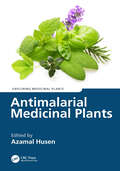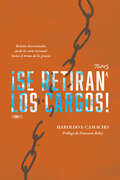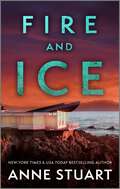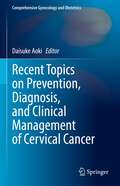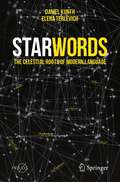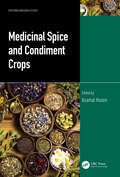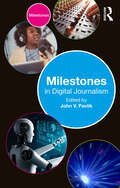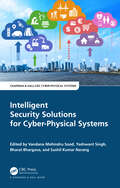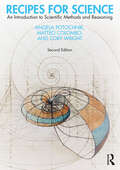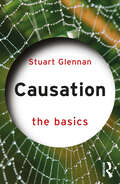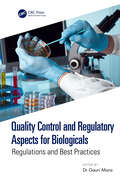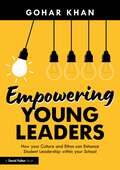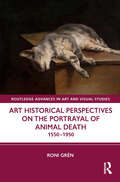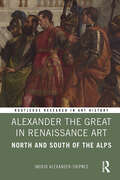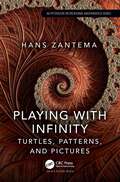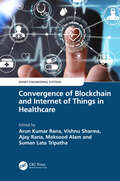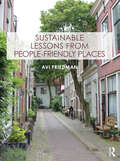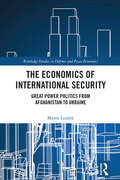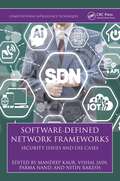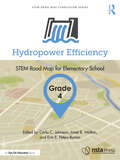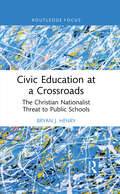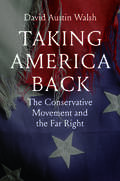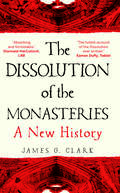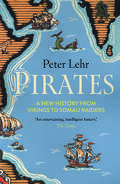- Table View
- List View
Antimalarial Medicinal Plants (Exploring Medicinal Plants)
by Azamal HusenMalaria continues to affect a large population of the world, especially in third world countries. The spread of drug-resistant parasites demonstrates the need for antimalarial agents with various modes of action. The search for remedies derived from medicinal plants for the treatment of malaria is reliant on accurate ethnobotanical and ethnopharmacological information obtained from traditional medical practitioners. Antimalarial Medicinal Plants provides information on bioactive compounds and therapeutic potentials of several antimalarial plant species found around the globe. This book evaluates these plant species with respect to their biology, diversity, distribution, and pharmacological values.A volume in the Exploring Medicinal Plants series, this book highlights trends, technologies, processes, and services important to and necessary for efficient production, use, and understanding of medicinal qualities of antimalarial plants. It critically examines claims made by traditional medical practitioners with scientific validations for safe herbal drug formulation. It is a reference work for researchers of herbal medicine, traditional healers, pharmacists, and students associated with plant sciences and economic botany.
¡Se Retiran Todos Los Cargos!: Relatos Devocionales Desde la Corte Terrenal Hasta el Trono de la Gracia, Tomo 2 (¡Se Retiran Todos Los Cargos! #2)
by Haroldo S CamachoSe siente un profundo temor cuando uno es llamado a comparecer ante un juez. Aunque solo sea por una multa de trá nsito. Especialmente si uno comparece sin un abogado. ¿ Cuá l será la multa? ¿ Habrá una defensa? ¿ Me declaro culpable, o pido un juicio? Pero cuando comparecemos ante el tribunal de Dios, todo temor se disipa: ¡ se retiran todos los cargos! Pero ¿ es verdad realmente? Hemos hecho tantas cosas que estamos convencidos de que no tenemos perdó n. Pensamos: « Tal como no se puede confiar plenamente en el sistema judicial, tampoco se puede confiar plenamente en el perdó n de nuestros pecados» . Pero el martillo del juez interrumpe nuestros titubeos: « Por causa de Cristo, se retiran todos los cargos, no hay nada pendiente. ¡ El defendido queda perdonado! ¡ Para siempre!» .El segundo tomo de ¡ Se retiran todos los cargos! continú a el viaje desde la corte terrenal hasta el trono de la gracia de Dios, en tanto Haroldo Camacho nos muestra que cada pecador recibe un veredicto de inocente, ¡ sin importar cuá n culpable sea!
Wild Iris Ridge (Hope's Crossing #7)
by RaeAnne ThayneLucy Drake and Brendan Caine have only one thing in common… And it's likely to tear them apart. Because it was Brendan's late wife, Jessie—and Lucy's best friend—who'd brought them together in the first place. And since Jessie's passing, Brendan's been distracted by his two little ones…and the memory of an explosive kiss with Lucy years before his marriage. Still, he'll steer clear of her. She's always been trouble with a capital T. Lucy couldn't wait to shed her small-town roots for the big city. But now that she's back in Hope's Crossing to take care of the Queen Anne home her late aunt has left her, she figures seeing Brendan Caine again is no big deal. After all, she'd managed to resist the handsome fire chief once before, but clearly the embers of their attraction are still smoldering….
Fire and Ice (The Ice Series #5)
by Anne StuartThe stunning finale to RITA Award-winner Anne Stuart&’s The Ice Series brings us back to Japan, where deadly machinations have an odd couple in their crosshairs.In the wake of a failed love affair, Jilly Lovitz takes off for Tokyo. She&’s expecting to cry on her sister&’s shoulder, then spend a couple months blowing off steam in Japan. Instead, she&’s snatched away on the back of a motorcycle, narrowly avoiding a grisly execution attempt meant for her sister and brother-in-law.Her rescuer Reno is the Committee&’s most unpredictable agent. They&’d met once before and the attraction was strange—opposites in more way than one—but electric. Now Reno and Jilly are pawns in a deadly tangle of assassination attempts, kidnappings, and prisoner swaps that could put their steamy partnership on ice.Previously published.
Recent Topics on Prevention, Diagnosis, and Clinical Management of Cervical Cancer (Comprehensive Gynecology and Obstetrics)
by Daisuke AokiThis book provides a practical overview of a central topic in cervical cancer concerning human papillomavirus (HPV), prevention, cervical cancer screening, diagnosis, and treatment. Since the finding of human papillomavirus (HPV) being the cause of cervical cancer and its precursor symptoms, effective screening based on HPV DNA testing and prevention methods by HPV vaccination are established. Furthermore, new surgical methods, radiation therapy, and drug therapy are developed. To summarize the history and the recent advancement, this book is presented in five attractive parts: pathogenesis and epidemiology, cancer screening and prevention strategies, diagnosis and clinical management of cervical intraepithelial neoplasia (CIN), surgical treatments, and multimodal therapy. Recent Topics on Prevention, Diagnosis, and Clinical Management of Cervical Cancer is an appealing source for gynecologists, gynecologic surgeons, gynecologic pathologists, and gynecologic, clinical, and radiation oncologists. Also, primary care doctors, public health nurses, nurses, and pharmacists involved in cancer and other medical personnel will find the information and challenges presented tempting.
StarWords: The Celestial Roots of Modern Language (Springer Praxis Books)
by Daniel Kunth Elena TerlevichUnbeknownst to many, our modern language contains countless words that were inspired by human observations of the cosmos. We now use words like “zenith”, “Monday”, “disaster”, “dog days”, “starfish”, “lunatic”, flu, and so many others, without a second thought for their celestial roots. Famous French astrophysicist Daniel Kunth invites you on a linguistic and scientific journey through space and time to explore these forgotten origins. You will be astonished to rediscover cosmic language hidden in plain sight through this wonderful collection of historical and cultural stories, famous idioms and delightful puns, along with the real science behind each one. Elena Terlevich is a well known professional astronomer working at INAOE in Mexico, an honorary Professor at La Plata University in Argentina and a regular visitor at the Institute of Astronomy in Cambridge (UK). Requiring no prior knowledge in astronomy or linguistics, this book’s universal contentsinvite the reader to ponder how our observations of the night sky have shaped our modern tongue and customs.
Medicinal Spice and Condiment Crops (Exploring Medicinal Plants)
by Azamal HusenSpices are used in small quantities to add flavor, aroma, color, and texture in food preparation. However, spices and condiments have also been recognized as having medicinal value. They have been used traditionally as curative and preventive agents, the bioactive compounds obtained from these plants are used in herbal drug formulations in modern times. Medicinal Spice and Condiment Crops provides a comprehensive overview on the medicinal properties of spices and condiments with focus on various phytochemicals derived from them.KEY FEATURES:• Examines spices and condiments with respect to their biology, diversity, distribution, and pharmacological values.• Explores the scientific validations of the therapeutic potentials of spice and condiment plant species.• Discusses the bioactive agents involved in alleviating symptoms of cardiovascular disease, cancer, diabetes, ulcers, skin disorders, and neurodegenerative diseases.• Explains specific medicinal features of spice and condiment-producing plant species inspiring research, discovery, and safe herbal drug formulation.A volume in the Exploring Medicinal Plants series, this book is useful for plant scientists, economic botanists, those who work with herbal and complementary medicine, as well as people working in the pharmaceutical industry.
Milestones in Digital Journalism (Milestones)
by John V. PavlikMilestones in Digital Journalism sets out ten defining moments that changed the way we understand, produce, finance and engage with the news today.Designed for weekly use on digital journalism courses, these ten milestones provide a conceptual roadmap to understanding the subject while drawing on case study examples which help students home in on key markers in its history. Each milestone is selected for its impact on the nature of journalism practice, the content of journalism, the structure of the journalism industry and/or public engagement in the news. Milestones are defined as the key markers in the development of digital journalism worldwide since the 1970s. The featured markers are diverse and global, ranging from the first virtual reality (VR) screening of Nonny de la Peña’s Hunger in Los Angeles at Sundance Film Festival, to citizen reporting of the police killing of George Floyd in 2020. Written by experts in each of the areas chosen, this book offers an inclusive and de-centred overview of the field and an ideal springboard for further study.Milestones are a range of accessible textbooks, breaking down the need-to-know moments in the social, cultural, political and artistic development of foundational subject areas.This book is key reading for students learning about the history of digital journalism worldwide.
Intelligent Security Solutions for Cyber-Physical Systems (Chapman & Hall/CRC Cyber-Physical Systems)
by Vandana Mohindru Sood Yashwant Singh Bharat Bhargava Sushil Kumar NarangA cyber-physical system (CPS) is a computer system in which a mechanism is controlled or monitored by computer-based algorithms and involves transdisciplinary approaches, merging theories of cybernetics, mechatronics, design, and process science. This text mainly concentrates on offering a foundational theoretical underpinning, and a comprehensive and coherent review of intelligent security solutions for cyber-physical systems. Features: • Provides an overview of cyber-physical systems (CPSs) along with security concepts like attack detection methods, cyber-physical systems failures, and risk identification and management. • Showcases cyber-physical systems (CPSs) security solutions, lightweight cryptographic solutions, and CPS forensics, etc. • Emphasizes machine learning methods for behavior-based intrusion detection in cyber-physical systems (CPSs), resilient machine learning for networked CPS, fog computing industrial CPS, etc. • Elaborates classification of network abnormalities in Internet of Things-based cyber-physical systems (CPSs) using deep learning. • Includes case studies and applications in the domain of smart grid systems, industrial control systems, smart manufacturing, social network and gaming, electric power grid and energy systems, etc.
Recipes for Science: An Introduction to Scientific Methods and Reasoning
by Angela Potochnik Matteo Colombo Cory WrightScientific literacy is an essential aspect of any undergraduate education. Recipes for Science responds to this need by providing an accessible introduction to the nature of science and scientific methods appropriate for any beginning college student. The book is adaptable to a wide variety of different courses, such as introductions to scientific reasoning, methods courses in scientific disciplines, science education, and philosophy of science.Special features of Recipes for Science include contemporary and historical case studies from many fields of physical, life, and social sciences; visual aids to clarify and illustrate ideas; text boxes to explore related topics; plenty of exercises to support student recall and application of concepts; suggestions for further readings at the end of each chapter; a glossary with helpful definitions of key terms; and a companion website with course syllabi, internet resources, PowerPoint presentations, lecture notes, additional exercises, and original short videos on key topics.Key Updates to the Second Edition 13 short chapters of uniform length that make it easier to adapt to a college semester Case studies and examples featuring new research and important historical research across many fields of science Added discussion of timely topics, including large research collaborations, trust and distrust of science, machine learning and other technology-driven advances, diversity in science, and connections to indigenous knowledge Streamlined and simplified discussion of some topics, such as experimentation and statistical hypothesis-testing Exercises that are clearly aligned with learning goals and sorted into types: Recall, Apply, and Think Additional online exercises and a series of original videos on key topics Exercise solutions available on an instructor-only section of the website
Causation: The Basics (The Basics)
by Stuart GlennanCausation: The Basics explores questions about what causes are, and how we come to know them, describe them, and put them to use. The book begins with an introduction to the history of philosophical thinking about causation, followed by a series of chapters introducing important contemporary accounts of causation. It concludes with chapters on causation and agency, causal discovery, and causal explanation. Key questions explored in the book include: What distinguishes correlation from causation? How are the causes of singular events related to more general patterns of cause and effect? How are commonsense, scientific, and legal conceptions of causation related? Can certain occurrences be singled out as the main or principle causes of some effect? Is there a place in the world’s causal structure for human agency and free will? While introducing the major philosophical debates about the nature of causation, Causation: The Basics emphasizes the uses and challenges of causal reasoning as it occurs in the sciences, engineering, medicine, and other areas of human life. With a glossary of key terms and suggestions for further reading, the book provides readers with a clear and concise introduction to both theoretical and practical questions about causation.
Quality Control and Regulatory Aspects for Biologicals: Regulations and Best Practices
by Gauri MisraThis book serves as a comprehensive guide on quality control and regulatory aspects for biological products. It covers a wide range of topics, including regulatory requirements, quality control strategies, analytical methods, and risk management. It delves into the advantages and limitations of in vivo tests and discusses alternative methods that can be employed. The book explores the use of animal-based testing methods in quality control and examines viable alternatives.Key Features: Reviews various scientific and regulatory aspects involved in the quality control of biologicals Provides an overview of the roles of various national and international regulatory bodies and accreditation agencies Presents advanced analytical methods, innovative technologies, and the integration of molecular diagnostics in quality control processes Explores the use of animal-based testing methods in quality control, as well as their alternatives Discusses guidelines and methodologies involved in the development of biological products Overall, this book is an important reference source for various professionals in the pharmaceutical industry, including researchers, scientists, quality control personnel, and regulatory affairs professionals.
Empowering Young Leaders: How your Culture and Ethos can Enhance Student Leadership within your School
by Gohar KhanThe ethos, culture, and climate of a school lie at the very heart of its success and have a dramatic impact on the future of its students. This exciting new book shows how through values-based, inclusive, and aspirational leadership, teachers and school leaders can support students in becoming well rounded, globally minded change-makers of the future. Based on the principle that every young person can be a leader, it offers step-by step guidance to support the development of leadership skills and shows how leadership opportunities can be made accessible to all learners.Arguing that leadership needs to be actively and inclusively taught, the book explores how young leadership models, reward systems, risk-taking, well-being strategies, and growth-mindset implementation can transform student motivation levels by creating aspiration, fulfilling dreams, and building character. Packed with practical suggestions and resources, the chapters cover: diversity and leadership establishing a strong student leadership team how to meaningfully mark significant global days making the most of tutor time student well-being fear of failure and how to overcome this building links with the local and wider community. Written by a Director of Ethos at an outstanding Trust, this is essential reading for all teachers and school leaders wanting their students to become empathetic, ambitious, values-driven, and happy young people.
Art Historical Perspectives on the Portrayal of Animal Death: 1550–1950 (Routledge Advances in Art and Visual Studies)
by Roni GrénThis study concentrates on the discourses around animal death in arts and the ways they changed over time.Chapter topics span from religious symbolism to natural history cabinets, from hunting laws to animal rights, from economic history to formalist views on art. In other words, the book asks why artists have represented animal death in visual culture, maintaining that the practice has, through the whole era, been a crucial part of the understanding of our relation to the world and our identity as humans. This is the first truly integrative book-length examination of the depiction of dead animals in Western art.The book will be of interest to scholars working in art history, animal studies, and cultural history.
Alexander the Great in Renaissance Art: North and South of the Alps (Routledge Research in Art History)
by Ingrid Alexander-SkipnesThis volume explores the images of Alexander the Great from the fifteenth and sixteenth centuries, how they came about, and why they were so popular.In contrast to the numerous studies on the historical and legendary figure of Alexander, surprisingly few studies have examined, in one volume, the visual representation of the Macedonian king in frescoes, oil paintings, engravings, manuscripts, medals, sculpture, and tapestries during the Renaissance. The book covers a broad geographical area and includes transalpine perspectives. Ingrid Alexander-Skipnes examines the role that humanists played in disseminating the stories about Alexander and explores why Alexander was so popular during the Renaissance. Alexander-Skipnes offers cultural, political, and social perspectives on the Macedonian king and shows how Renaissance artists and patrons viewed Alexander the Great.The book will be of interest to scholars working in art history, Renaissance studies, ancient Greek history, and classics.
Playing with Infinity: Turtles, Patterns, and Pictures (AK Peters/CRC Recreational Mathematics Series)
by Hans ZantemaThis is a book about infinity - specifically the infinity of numbers and sequences. Amazing properties arise, for instance, some kinds of infinity are argued to be greater than others. Along the way the author will demonstrate how infinity can be made to create beautiful ‘art’, guided by the development of underlying mathematics. This book will provide a fascinating read for anyone interested in number theory, infinity, math art, and/or generative art, and could be used a valuable supplement to any course on these topics.Features: Beautiful examples of generative art Accessible to anyone with a reasonable high school level of mathematics Full of challenges and puzzles to engage readers
Convergence of Blockchain and Internet of Things in Healthcare (Smart Engineering Systems: Design and Applications)
by Arun Kumar Rana, Vishnu Sharma, Ajay Rana, Maksud Alam and Suman Lata TripathiThe Internet of Things (IoT) and blockchain are two new technologies that combine elements in many ways. A system where the virtual and physical worlds interact is created by integrating pervasive computing, ubiquitous computing, communication technologies, sensing technologies, Internet Protocol, and embedded devices. A massive number of linked devices and vast amounts of data present new prospects for developing services that can directly benefit the economy, environment, society, and individual residents. Due to the size of IoT and insufficient data security, security breaches may have a huge impact and negative effects. IoT not only connects gadgets but also people and other entities, leaving every IoT component open to a wide variety of assaults. The implementation and application of IoT and blockchain technology in actual scientific, biomedical, and data applications are covered in this book. The book highlights important advancements in health science research and development by applying the distinctive capabilities inherent to distributed ledger systems. Each chapter describes the current uses of blockchain in real-world data collection, medicine development, device tracking, and more meaningful patient interaction. All of these are used to create opportunities for expanding health science research. This paradigm change is studied from the perspectives of pharmaceutical executives, biotechnology entrepreneurs, regulatory bodies, ethical review boards, and blockchain developers.Key Features: Provides a foundation for the implementation process of blockchain and IoT devices based on healthcare-related technology Image processing and IoT device researchers can correlate their work with other requirements of advanced technology in the healthcare domain Conveys the latest technology, including artificial intelligence and machine learning, in healthcare-related technology Useful for the researcher to explore new things like security, cryptography, and privacy in healthcare related technology Tailored for people who want to start in healthcare-related technology with blockchain and IoT This book is primarily for senior undergraduates, graduate students, and academic researchers in the fields of electrical engineering, electronics and communication engineering, computer science and engineering, and biomedical engineering.
Sustainable Lessons from People-Friendly Places
by Avi FriedmanCurrent planning and design modes of cities are facing challenges of philosophy and form. Past approaches no longer sustain new demands and call for innovative thinking. In a world that is becoming highly urbanized, the need for a new outlook is propelled by fundamental global changes that touch upon environmental, economic and social aspects.The book introduces fundamental principles of timely sustainable urban design, paying attention to architecture, integration of natural features, public urban spaces and their successful use. Readers will learn how cities are transitioning to active mobility by placing the wellbeing of citizens at the heart of planning; making buildings fit nature; supporting local culture through preservation; and including community gardens in neighborhoods, among others. Written by a practicing architect, professor and author, the book is richly illustrated and features meticulously selected international case studies.
The Economics of International Security: Great Power Politics from Afghanistan to Ukraine (Routledge Studies in Defence and Peace Economics)
by Marek LoužekInternational relations since the end of the Cold War have been relatively uneasy, yet we should not discount the fact that the intensity of conflicts has decreased compared to the situation in both the first and second halves of the 20th century. This book explores international security relations as the pandemic subsides and the war in Ukraine escalates, offering a good description of the main actors and the background of current threats.It lays the theoretical foundations for security economics, analyses U.S. foreign policy, introduces China as a new superpower and signals Russia as a great power in decline. It concludes by pointing out the pitfalls of exporting democracy and presenting the paradox of progress. The author asserts that we should not be alarmed that international relations are shifting. Following the Cold War, the U.S. achieved clear strategic and economic superiority, however, China, Russia, India and other great powers remain strong players that must be taken seriously.The book shows that asymmetric warfare often ends with the weaker side winning and the stronger one losing and being discredited. Different examples of this outcome include the American War in Vietnam (1965-73), the Soviet Union's defeat in Afghanistan (1979-1990), and the U.S. getting mired in the wars of Afghanistan and Iraq. The war in Ukraine is a demonstration of the illusion of an imperial power that believes it can impose its will on other nations, even against their will.The book will be a useful resource for academics, students and researchers, as well as policymakers and professionals interested in issues related to international security and defense.
Software-Defined Network Frameworks: Security Issues and Use Cases (ISSN)
by Mandeep Kaur Vishal Jain Parma Nand Nitin RakeshSoftware-Defined Networks (SDN) work by virtualization of the network and the Cognitive Software-Defined Network (CSDN) combines the efficiencies of SDN with cognitive learning algorithms and enhanced protocols to automatize SDN. Partial deployment of SDN along with traditional networking devices forms a Hybrid Software-Defined Network (HSDN). Software-Defined Network Frameworks: Security Issues and Use Cases consolidates the research relating to the security in SDN, CSDN, and Hybrid SDNs. The security enhancements derived from the use of various SDN frameworks and the security challenges thus introduced, are also discussed. Overall, this book explains the different architectures of SDNs and the security challenges needed for implementing them.Features: Illustrates different frameworks of SDN and their security issues in a single volume Discusses design and assessment of efficient SDN northbound/southbound interfaces Describes cognitive computing, affective computing, machine learning, and other novel tools Illustrates coupling of SDN and traditional networking – Hybrid SDN Explores services, technologies, algorithms, and methods for data analysis in CSDN The book is aimed at researchers and graduate students in software engineering, network security, computer networks, high performance computing, communications engineering, and intelligent systems.
Hydropower Efficiency, Grade 4: STEM Road Map for Elementary School (STEM Road Map Curriculum Series)
by Carla C. Johnson Janet B. Walton Peters-Burton, Erin E.What if you could challenge your fourth graders to create a minimally invasive, highly efficient dam? With this volume in the STEM Road Map Curriculum Series, you can! Hydropower Efficiency outlines a journey that will steer your students toward authentic problem solving while grounding them in integrated STEM disciplines. Like the other volumes in the series, this book is designed to meet the growing need to infuse real-world learning into K–12 classrooms.This interdisciplinary, four-lesson module uses project- and problem-based learning to help students create a highly efficient dam that has a minimal impact on the environment. Students will explore the use of natural resources to provide energy needs, specifically hydropower, while exploring the workings of watermills, wind turbines, and generators to help build an understanding of the effects of dams. In creating their dam, they will learn about the various types of alternative hydropower sources, including wave and tidal power, and track the progress of electrification in the U.S. on a timeline; alongside researching the positive and negative consequences of hydropower.To support this goal, students will do the following: Use the engineering design process (EDP) to create a design for a dam, wind turbine, and water wheel Compare and contrast renewable power sources Evaluate power sources for efficiency Identify positive and negative consequences of human modifications of the environment Identify and describe how several sources of renewable energy are used across the U.S. Use mapping skills to determine where natural resources are being accessed for energy usage Effectively utilize shapes, materials, and measurements to create a model of a hydropower system The STEM Road Map Curriculum Series is anchored in the Next Generation Science Standards, the Common Core State Standards, and the Framework for 21st Century Learning. In-depth and flexible, Hydropower Efficiency can be used as a whole unit or in part to meet the needs of districts, schools, and teachers who are charting a course toward an integrated STEM approach.
Civic Education at a Crossroads: The Christian Nationalist Threat to Public Schools (Routledge Research in Character and Virtue Education)
by Bryan J. HenryThis book turns to political theory as a framework for understanding the rise of political and religious extremism, and in particular the Christian Nationalist position, identifying solutions to civic challenges, and arguing for the vital role that public schools play in providing the civic education that prepares young people for participation in democratic self-government.Drawing on scholarly debates between liberal and republican political theorists, the author maintains that if we want to preserve our republic, then policymakers and educators must unapologetically promote a normative “vision of good citizenship” that cultivates in students the requisite civic virtue and rational autonomy needed to defend democracy from the rise of illiberal extremism. A timely contribution to academic debates about the role of civic education in the preservation of democracy, it will appeal to scholars, educators and policymakers concerned with the future of civic education, as well as the philosophy of education, political science, and educational policy.
Taking America Back: The Conservative Movement and the Far Right
by David Austin WalshA provocative look at the relationship between the far right and the American conservative movement from the 1930s to the end of the Cold War Since 2016, many commentators have expressed shock at the so-called rise of the far right in America at the expense of "responsible" and "respectable" conservatism. But is the far right an aberration in conservative politics? As David Austin Walsh shows, the mainstream conservative movement and the far right have been intertwined for nearly a century, and both were born out of a "right-wing popular front" linking racists, anti-Semites, and fascists in a broad coalition opposed to socialism, communism, and New Deal liberalism. Far from being outliers in the broader conservative coalition, these extremist elements were foundational in the creation of a right‑wing political culture centered around shared political enemies, a penchant for conspiracy theories, and a desire to restore America to its "authentic" pre–New Deal values. The popular front included Merwin Hart, a New York business lobbyist active in far-right circles who became a lobbyist for the Franco regime in Spain, the original "America First" movement, the movement to prevent Jewish immigration to the United States after World War II, the John Birch Society, the American Nazi Party, the George Wallace presidential campaign of 1968, the fight over the National Endowment for the Humanities, and Pat Buchanan’s support of Nazi war criminal John Demjanjuk during the Reagan Administration. And connecting this disparate coalition was William F. Buckley, Jr., the editor of National Review and America’s leading "responsible conservative.&rdquo
The Dissolution of the Monasteries: A New History
by James ClarkThe first account of the dissolution of the monasteries for fifty years—exploring its profound impact on the people of Tudor England "This is a book about people, though, not ideas, and as a detailed account of an extraordinary human drama with a cast of thousands, it is an exceptional piece of historical writing."—Lucy Wooding, Times Literary Supplement Shortly before Easter, 1540 saw the end of almost a millennium of monastic life in England. Until then religious houses had acted as a focus for education, literary, and artistic expression and even the creation of regional and national identity. Their closure, carried out in just four years between 1536 and 1540, caused a dislocation of people and a disruption of life not seen in England since the Norman Conquest. Drawing on the records of national and regional archives as well as archaeological remains, James Clark explores the little-known lives of the last men and women who lived in England’s monasteries before the Reformation. Clark challenges received wisdom, showing that buildings were not immediately demolished and Henry VIII’s subjects were so attached to the religious houses that they kept fixtures and fittings as souvenirs. This rich, vivid history brings back into focus the prominent place of abbeys, priories, and friaries in the lives of the English people.
Pirates: A New History, from Vikings to Somali Raiders
by Peter LehrA global account of pirates and their modus operandi, from the Middle Ages to the present day In the twenty-first century piracy has regained a central place in Western culture, thanks to a surprising combination of Johnny Depp and the Pirates of the Caribbean franchise as well as the dramatic rise of modern-day piracy around Somalia and the Horn of Africa. In this global history of the phenomenon, maritime terrorism and piracy expert Peter Lehr casts fresh light on pirates. Ranging from the Vikings and Wako pirates in the Middle Ages to modern-day Somali pirates, Lehr delves deep into what motivates pirates and how they operate. He also illuminates the state’s role in the development of piracy throughout history: from privateers sanctioned by Queen Elizabeth to pirates operating off the coast of Africa taking the law into their own hands. After exploring the structural failures which create fertile ground for pirate activities, Lehr evaluates the success of counterpiracy efforts—and the reasons behind their failures.
